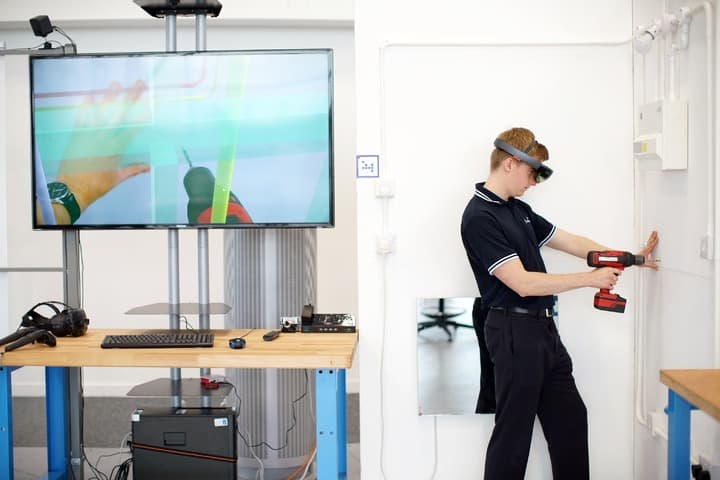“A journey of a thousand miles begins with a single step” (Lao Tzu)
For all too many manufacturers the idea of embarking on the journey towards Industry 4.0 is more a giant leap of faith than a small first step towards a well-defined goal. And while the ancient Chinese sage may not be the ideal companion on that journey, his advice on how best to set out is well worth heeding.

The journey should begin, not with the idea of completing it one frenzied, exhausting sprint, but with a carefully constructed plan broken down into a controlled series of achievable and affordable steps. With a clear understanding of the terrain to be crossed, the hurdles and challenges to be overcome, and the realisable benefits to be gathered along the way, IR4 is thus transformed from a potentially expensive nightmare into affordable dream.
But where do you gain that clear understanding?
Well, you could do worse than come to the Advanced Manufacturing Research Centre, or any of the other six high value manufacturing catapults dotted about the country.
We like to think of the AMRC as the place where digital meets manufacturing: and, while that view is shared by the likes Boeing, McLaren and Rolls Royce, it is equally embraced by the Cardboard Box Company employing 80 people in Accrington; the family run Footprint Tools in Sheffield employing a workforce much reduced by competition from the Far East; and MTT in Padiham employing 25 skilled engineers who turn old machine tools into better-than-new, fit-for-purpose equipment using the sorcery of sensors, cloud and edge analytics, and many other elements of I4.0 technology.
All of these SMEs started out on their I4.0 journey as sceptics. Many remain so: such is the nature of the curious, quizzical, inquiring engineer. But, presented with the evidence by our talented young engineers with no product to sell or commission to make, and shown first-hand the art (and science) of the possible, all were quickly convinced that cost was no barrier to making that first step.
To prove our point on cost, we recently took two venerable early post-war machine tools – a Bridgeport from the USA and a Colchester lathe from England – and equipped them with off-the-shelf, cheap as chips (forgive the pun) sensors that turned them from being dumb beasts of burden, into something approaching intelligent digital thoroughbreds.
You can see them in action at MACH this week. A glance at a screen tells the operator all he needs to know about the how the machine is performing. And, while a highly experienced, time-served operator might have ‘sensed’ the import of this data himself, such hard won knowledge and expertise is disappearing even faster than the Bridgeports.
Affordable sensors, linked to a basic laptop, can not only keep the machines running efficiently, reduce downtime, support predictive maintenance, they also address the looming succession crisis facing small and medium sized manufacturers with ageing workforces.
OK, the legacy equipment is as much a marketing tool as a machine tool. But the point they prove is clear: cost need not be a deterrent to embarking on the I4.0 journey. They also serve as what we call ‘demonstrators.’ These bring I4.0 to life in a way enables manufacturers to not only see the art of the possible, but to directly experience it.
And that’s the essence of the partially constructed Caterham, which has pride of place at MACH. Project RAID (Reconfigurable Assembly Integrated Demonstrator) takes Colin Chapman’s iconic kit car and turns it into a high-powered showcase for digital manufacturing technologies that don’t cost the earth and are simple to work with. Half the Caterham was assembled by hand, as per the written instructions, the other half by employing advanced manufacturing technologies, collecting data about the various construction processes along the way.
The digital aspects of the project show SMEs how the data collected can rid processes of non-value added time and provide visibility to create viable business cases to show how and where improvements can be made in manufacturing productivity. Direct, low-level, real-time insights into the manufacturing process via seamless integration into ‘off-the-shelf’ MES and shop-floor software systems re-inforce strategic decisions and allow process changes to be well-informed.
The project shows manufacturers from any sector how easy-to-deploy, data-powered I4.0 technologies can be tailored to any complex full assembly process with a short lead time. As with the legacy lathes, these technologies are hardware agnostic: the same information can be obtained from small, low cost sensors as from data collected by large, robust industrial networks of high-end equipment. Deploying them will make SMEs as fast and nimble as Chapman’s Caterham itself.
So, the word from the AMRC at MACH?
Heed the sage advice. Make that first small step on the I4.0 journey by visiting us at MACH. Your second step could be a visit us in Sheffield to map out the next steps. For, as Lao Tzu also said: if you don’t change direction, you may end up where you are heading.




Swiss geoengineering start-up targets methane removal
No mention whatsoever about the effect of increased methane levels/iron chloride in the ocean on the pH and chemical properties of the ocean - are we...